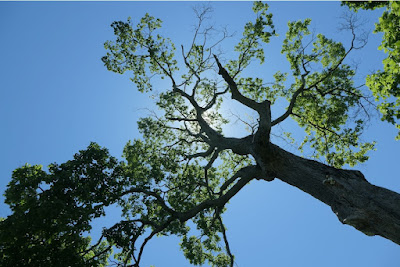On June 3rd Joan and I visited Dawes Arboretum, to get in a walk and to see their latest exhibit, "Avian Avatars." Our first stop before spending time on foot, whether civilized or rough, is always at the visitor's center rest rooms. On that short hop there was plenty to see. (Click on any image to enlarge.) Here, gladiator allium.
 |
Note the bee visiting the right bloom.
|
A fabulous spiderwort.Digitalis, often called "foxglove."
A green cloud -- soft, fuzzy fennel, likely foeniculum vulgare 'Purpureum.'From that side of the visitor's center we could see one of the sculptures of bamboo and recycled materials.
But we first set out to the west, and the demonstration garden.Looking west, back towards Columbus, is to view the scrubbed landscape left behind by the last glacial period. Here we found the owl. |
That's Joan in there.
|
On the other side of the demonstration garden there was a fabulous yellow maple.Down the hill and towards the pond, Joan and I encountered the sandhill crane.You can walk through it, if you're careful. |
The passage narrows at the top!
|
Continuing on, we arrived at the peacock.Even from there, we saw a "big bird" off in the distance -- a male cardinal.He was accompanied by his lady friend.A short video clip combining the peacock and female cardinal, who both sported whirling headgear. I deleted the audio due to excess background chatter.
Of course, Dawes is an arboretum, and blooms continued to grab our notice. Here's some rhododendron.
Next, we encountered this gorgeous bluebird.We continued to the southern trails, beyond the sculptures, and to our delight on Oak Hill saw a hawk atop our favorite black maple.The maple backlit by the sun.Our return towards the parking area exposed us to the vigilant owl.We'd been looking for a warm-up hike with a lot of interest, and this visit to Dawes certainly fit the bill.







































